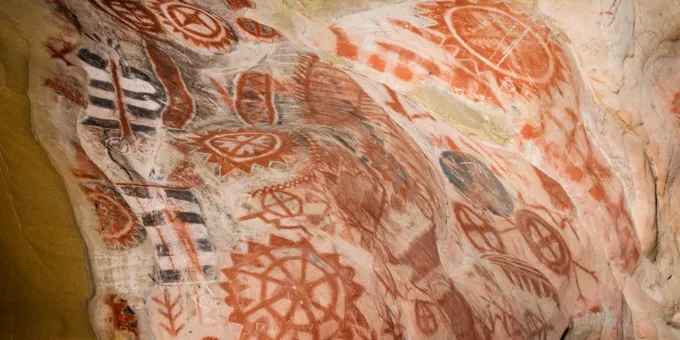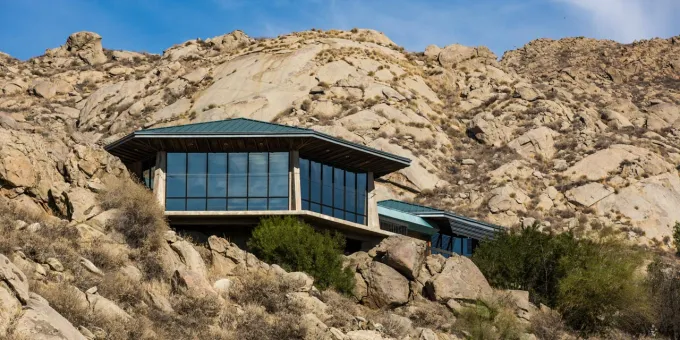With more than 100 tribes and a human history dating back thousands of years, California is filled with onetime Native American settlements and cultural sites. Many are located on tribal land with limited or no public use, but a number of culturally significant places are accessible at California’s state parks. In fact, the California State Park system preserves what its website describes as “an unparalleled collection of culturally and environmentally sensitive features and ancient habitats, including many significant California Indian villages.”
Visit the state parks and you can learn about local and regional Native American history in park museums and also explore areas that have changed little since the time before the arrival of Europeans, when up to 1 million indigenous people lived in California. Ranging from the Central Coast to the desert, the following destinations in the southern half of the state are among those identified by the state parks as offering the best opportunities to discover the world of California’s indigenous peoples.
The following parks are listed north to south.
Santa Cruz Mission State Historic Park
The 12th in the chain of California missions established by Spanish missionaries, Santa Cruz Mission State Historic Park tells the story of the Ohlone and Yokuts Indians who suffered from disease and labored under cruel conditions here. To put events into perspective, the park’s website describes the mission as “a site of great loss and trauma” that belongs to the “complex and difficult history” and “devastating legacy” of the Spanish mission system.
On the ancestral lands of today’s Amah Mutsun Tribal Band, the park has an original one-story adobe built by and used as housing for the mission’s indigenous people. It’s the only surviving structure of its kind in California, and the seven-room building has a museum that recounts the impacts of the mission system on the Ohlone and Yokuts individuals and their traditional cultures.
Monterey State Historic Park
With its collection of 19th-century residential, governmental, and commercial buildings, Monterey State Historic Park preserves the world of California’s first capital. While the focus is primarily on Monterey during its Spanish, Mexican, and American eras, the park’s Pacific House Museum has an impressive assortment of Native American crafts and artifacts displayed on its second floor.
Built in 1847, the Monterey Colonial–style adobe building served many functions—courthouse, jail, tavern, and newspaper office—before opening as a museum in 1957. The collection isn’t limited to California tribes, so in addition to Pomo baskets, you’ll also find Southwest pottery and weavings, Plains Indian deerskin robes and moccasins with exquisite beadwork, and crafts from Alaska’s Aleutian Islands.
Tomo-Kahni State Historic Park
The ancestral home of the Kawaiisu people, Tomo-Kahni State Historic Park outside Tehachapi (about 40 miles southeast of Bakersfield) is only open for guided tours on spring and fall weekends because of the highly sensitive nature of the site.
An orientation takes place at the Tehachapi Museum before participants caravan 12 miles to the park. The outing involves a three-mile hike during which you’ll get spectacular views of the Tehachapi Valley and Sand Canyon, as well as looks at archaeological sites, including a painted cave. Reservations are highly recommended for the four-hour tour.
A Shoshonean tribe, the Kawaiisu lived in the Tehachapi area for as long as 3,000 years after migrating from the Great Basin. They were known for their basketry, and the Chemehuevi of the Colorado River region are considered their closest modern-day relatives.
La Purísima State Historic Park
Considered the most completely restored of California’s 21 missions, Mission La Purísima Concepcíon was at the center of 300,000 acres of traditional Chumash lands. The complex of buildings is part of La Purísima Mission State Historic Park on the edge of the city of Lompoc, in northern Santa Barbara County. What distinguishes this state park is that it includes nearly 2,000 acres of chaparral- and oak-covered hills, where you can hike and discover the natural world that the Chumash would have known. The park also has traditional Chumash dwellings in a reconstructed village.
Chumash Painted Cave State Historic Park
Hidden away off Highway 154 between Santa Barbara and the Santa Ynez Valley, the rock art at Chumash Painted Cave State Historic Park dates back at least to the 1600s. These pictographs are found on the walls of a small sandstone cave within the traditional lands of the Barbareño Band of Chumash Indians. A short trail leads to the cave, where a heavy and locked iron gate prevents entry to protect the paintings from vandalism. But you can peer through the gate and see the pictographs. After visiting the cave and seeing the paintings in their natural setting, you can view close-up details of the rock art by visiting an online virtual tour.
Antelope Valley Indian Museum State Historic Park
The Antelope Valley was part of a major trade corridor used by three groups of Native Americans, and at the Antelope Valley Indian Museum State Historic Park you can see a remarkable collection of rare artifacts and crafts from the Southwest, California, and Great Basin. The museum is housed in Swiss chalet–style building constructed in 1928 and set within a formation of giant boulders at Piute Butte east of Lancaster. Its baskets, pottery, Katsina dolls, and blankets come from the collections of Howard Arden Edwards, the artist and Hollywood set designer who constructed the house, and Grace Wilcox Oliver, who bought the property in 1939 and later opened the museum.
Lake Perris State Recreation Area
As popular as Lake Perris State Recreation Area is with boaters and anglers, there’s more to this Riverside County destination than the shimmering reservoir that impounds drinking water for the California State Water Project. The recreation area’s 8,800 acres include sage scrub and chaparral habitat where the ranges of two native groups, the Cahuilla and the Luiseño, overlapped. Their modern descendants include the Agua Caliente Band of Cahuilla Indians and the Pechanga Band of Indians.
Faded remnants of petroglyphs and pictographs still adorn some boulders near the lake. Named for a Cahuilla word that meant “home of the wind,” the recreation area’s Ya’i Heki’ Regional Indian Museum tells the story of the indigenous peoples who ranged through the Perris Valley, and also hosts occasional lectures and special events.
Anza-Borrego Desert State Park
The largest state park not only in California but in the Lower 48, 600,000-acre Anza-Borrego Desert State Park east of San Diego is home to thousands of archaeological sites. The area was a meeting ground for several different Southern California indigenous peoples, including the Kumeyaay, Cupeño, Cahuilla, and Diegueño.
One of the park’s top Native American destinations is the 4,557-acre Little Blair Valley Cultural Preserve, where the Kumeyaay harvested agaves and juniper berries in spring. Within the preserve, there’s a short interpretive trail to an area of grinding holes as well as the two-mile round-trip Pictograph Trail that leads to a spot with rock art.
Because of the remoteness of many park areas, your first stop should be the excellent park visitor center at Borrego Springs, where you can check on conditions and see exhibits on native life. The Anza-Borrego Natural History Association is another great source of information and has background on Native American sites in the park’s northern, central, and southern sections. The association also offers a busy schedule of hikes and lectures.
Cuyamaca Rancho State Park
Spreading out over nearly 25,000 acres of oak and pine forest in the Peninsular Ranges east of San Diego, Cuyamaca Rancho State Park is the homeland of the Kumeyaay Indians, whose descendants are members of 12 modern-day Southern California bands, including the Barona, Sycuan, and Viejas. More than 100 miles of trails range through the park, which, before the arrival of the Spanish, was the site of numerous Kumeyaay villages. Cuyamaca is a Spanish variation of Ah-Ha Kwe-Ah Mac, a Kumeyaay term which translates as “the place where it rains.” As you explore the park, look for bedrock mortars and stop into the visitor center for more information on the Kumeyaay.

